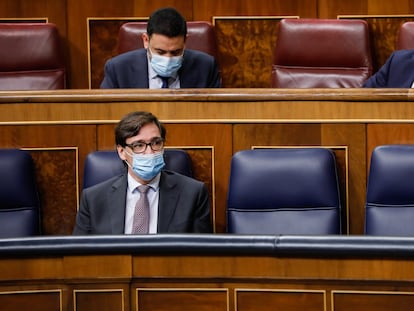Second wave ‘probably’ starting to stabilize in Spain, says Health Ministry official
The latest report presented on Thursday by Fernando Simón included 13,318 new coronavirus cases, after antigen test results were incorporated into the data

The Health Ministry is to start including antigen test results in its daily coronavirus reports in order to avoid a distortion that has been present in the figures, given that as many as 65,000 diagnoses were being left out of the totals. The result of this on Thursday was the incorporation of 13,318 cases, the second-highest figure from this second wave of the pandemic in Spain so far.
This change in the figures is due mostly to the Madrid, Murcia and Castilla y León regions, according to Fernando Simón, the director of the Health Ministry’s Coordination Center for Health Alerts (CCAES), speaking last night at a press conference to present the latest data. According to Simón, who has been the visible face of the government during the health crisis, the second wave is “probably” starting to stabilize in Spain, although he did leave open the possibility that the currently flat curve could start to rise once more.
The incorporation of results from antigen tests has not altered the falling positivity rate of diagnoses in Madrid, which came down from 17.7% to 15.6%
The data for new infections are still rising, but are doing so at a slower pace according to Thursday’s report. For example, reports from this week include 60,000 new cases, while those from the previous week totalled 68,000. The 14-day cumulative number of coronavirus cases per 100,000 inhabitants, a key indicator for tracking the progress of the pandemic, is currently at 269.96, while the total number of infections diagnosed in Spain since the crisis began is now 921,374.
The incorporation of results from antigen tests has not altered the falling positivity rate of diagnoses in Madrid, which came down from 17.7% to 15.6% from Wednesday to Thursday. The Madrid regional government, which is bitterly opposed to the state of alarm and perimetral confinements that have been imposed on it by the central administration, had been accused of reducing the number of PCR tests it is carrying out in order to improve its coronavirus data, a charge it vigorously denied, pointing to a marked increase in antigen tests.
Of the 17 regions in Spain and two North African exclave cities – Ceuta and Melilla – included in the Health Ministry’s report, Navarre is currently in the worst situation, with a 14-day cumulative number of coronavirus cases per 100,000 inhabitants of 811. There are only four regions where this indicator fell in the last 24 hours: Andalusia, Canary Islands, Ceuta and Madrid.
In terms of victims, yesterday’s report added 140 coronavirus deaths to the total, up from 109 in Wednesday’s figures
Examining the trends, Simón explained on Thursday evening that there are nine regions where the epidemic can be seen to be on the decline and two where it has stabilized. He went on to state that in terms of territories, i.e. provinces and islands, there are 34 of a total of 57 where the pandemic is “stabilized or clearly descending.”
In terms of victims, yesterday’s report added 140 coronavirus deaths to the total, up from 109 in Wednesday’s figures. Simón explained that it is logical that this number should rise, given that the number of cases began to go up two to three weeks ago. The official death toll is now 33,553. This figure does not, however, include the thousands of undiagnosed fatalities from the first wave of the epidemic in Spain. According to data from civil registries, there were 53,000 excess deaths in the country between March and September.
The Health Ministry is preparing a new series of indicators for the country in order to determine when stricter restrictions must be put in place. For now, there are three criteria that were established by Spain’s regions and the ministry for action to be taken: a 14-day cumulative number of coronavirus cases per 100,000 inhabitants that exceeds 500; 35% of intensive care unit (ICU) beds occupied by Covid-19 patients; and a positivity rate in excess of 10%. Madrid continues to meet two of these criteria, with 37% of ICU beds taken up by coronavirus patients and a positivity rate of 15.6%.
English version by Simon Hunter.
Tu suscripción se está usando en otro dispositivo
¿Quieres añadir otro usuario a tu suscripción?
Si continúas leyendo en este dispositivo, no se podrá leer en el otro.
FlechaTu suscripción se está usando en otro dispositivo y solo puedes acceder a EL PAÍS desde un dispositivo a la vez.
Si quieres compartir tu cuenta, cambia tu suscripción a la modalidad Premium, así podrás añadir otro usuario. Cada uno accederá con su propia cuenta de email, lo que os permitirá personalizar vuestra experiencia en EL PAÍS.
¿Tienes una suscripción de empresa? Accede aquí para contratar más cuentas.
En el caso de no saber quién está usando tu cuenta, te recomendamos cambiar tu contraseña aquí.
Si decides continuar compartiendo tu cuenta, este mensaje se mostrará en tu dispositivo y en el de la otra persona que está usando tu cuenta de forma indefinida, afectando a tu experiencia de lectura. Puedes consultar aquí los términos y condiciones de la suscripción digital.
More information
Últimas noticias
Maduro pleads not guilty before the federal court in New York: ‘I am still the president of Venezuela’
A new test can detect Alzheimer’s from a finger prick
UN team enters Sudanese city of El Fasher after paramilitary massacre: ‘It’s like a ghost town’
A recipe for resistance: Indigenous peoples politicize their struggles from the kitchen
Most viewed
- Gilles Lipovetsky: ‘If you want to live better and fall in love, take Prozac, don’t look to philosophy’
- Alain Aspect, Nobel laureate in physics: ‘Einstein was so smart that he would have had to recognize quantum entanglement’
- Alvin Hellerstein, a 92-year-old judge appointed by Bill Clinton, to preside over Maduro’s trial in New York
- Why oil has been at the center of Venezuela-US conflicts for decades
- Maduro’s downfall puts China’s relationship with Venezuela to the test










































